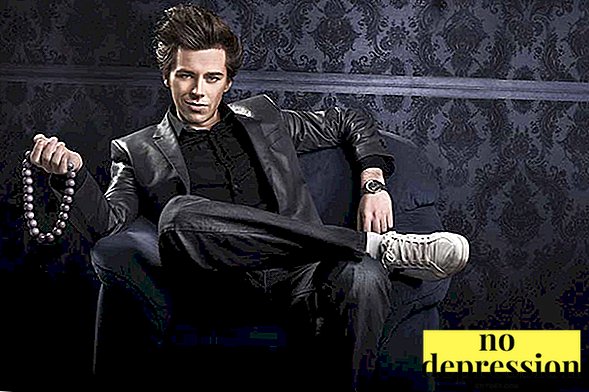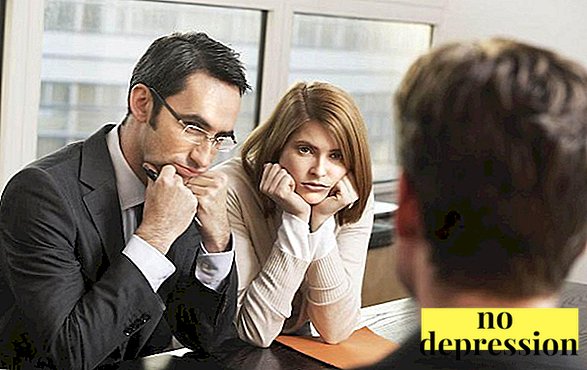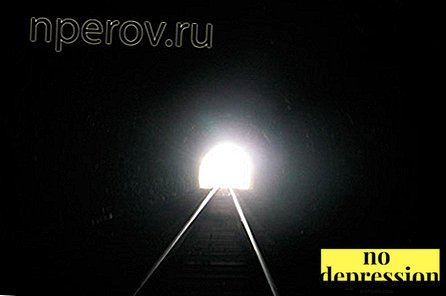Acrophobia is a pathological fear of heights. Symptoms of this type of phobia can occur regardless of age person
The difficulty of diagnosing acrophobia is hampered by certain nuances.
Elevation can provoke a feeling of fear in almost every person, in rare cases, a sense of emotional discomfort is completely absent. Normal form of alarm and pathological fear have a specific facet.
Definition and species
 Fear of heights is called acrophobia. Acrophobia is considered mild neurotic state.
Fear of heights is called acrophobia. Acrophobia is considered mild neurotic state.
In most cases, the pathology does not lead to complications, but its presence always indicates an increased risk of developing mental disorders and the presence of imbalances in the body.
Acrophobia is significantly different from the normal sense of fear of heights.
This phobic condition accompanied by characteristic symptoms and involves the use of various methods of treatment.
Acrophobia can be complemented by other phobic states:
- bathophobia (fear of a sudden change in height);
- klimakofobiya (fear of stairs);
- aerophobia (fear of flying);
- Illingofobiya (fear of dizziness at a height).
What is expressed?
With acrophobia, a person feels panic fear, not only at a height, but also in the form of thematic images (for example, parachutists, skyscrapers, mountain peaks, etc.). Phobia can occur with varying degrees of intensity.
 Mild degree is accompanied by an attack of fear, nausea and dizziness.
Mild degree is accompanied by an attack of fear, nausea and dizziness.
With severe stages occur physiological signs phobic state (allergic reaction, fainting, panic attack, etc.).
Panic fear in acrophobia people experiencing in the following situations:
- the rise on the Ferris wheel or the presence on viewing platforms;
- high-rise balconies on the balconies (including the view from the window);
- flight by plane (as well as other equipment used for the flight);
- movement over bridges (height does not matter);
- being at any height (in severe cases).
Normal form of anxiety and pathological fear of heights - the verge
Being at the height, most people have a natural feeling of fear. If emotional discomfort is felt in combination with dizziness, then such a state not considered a deviation from the norm.
In addition, height plays an important role (top of the mountain, skyscraper, or a small distance from the ground). Acrophobes experience panic at any elevation.
Even getting on the chair becomes difficult for them. Fear causes body stupor, speech and motor coordination, as well as other symptoms of phobia.
Norm indicators:
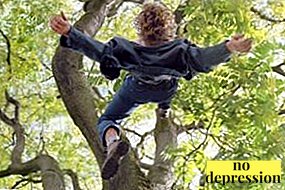 If a person has suffered an injury as a result of a fall from a height, then for a certain time he will have a fear of high objects (if the state does not normalize within a few months, then specialist help is needed).
If a person has suffered an injury as a result of a fall from a height, then for a certain time he will have a fear of high objects (if the state does not normalize within a few months, then specialist help is needed).- The normal form of anxiety is considered to be the emergence of fear when at a height that creates a potential threat to life (for example, being on the balcony of the upper floors of a high-rise building, such fear will be natural).
What is acrophobia? An excerpt from the television series "Secrets of Fears" dedicated to acrophobia - an obsessive fear of heights:
Probable causes
Why are people afraid of heights? Acrophobia can be congenital or acquired. In the first case, an important role is played by genetic predisposition and abnormalities of the psycho-emotional state.
Acquired form of phobia becomes the body's response to specific situations that a person had to go through.
To identify the factors that provoked the development of pathological fear, it is enough to analyze the patient's explanations, but sometimes for this complex examination may be required using psychotherapeutic procedures.

Possible causes Acrophobia can be the following factors:
- excessive susceptibility (as a character trait);
- weakness of the vestibular apparatus;
- fall from height, accompanied by physical or emotional trauma;
- children's fears (emotional stress associated with height).
How does it manifest itself?
Acrophobia can be accompanied not only by mental signs, but also by vegetative symptoms. The key role is played by the general state of the human psyche and the degree of progression of the phobia.
In severe cases, the height can provoke a panic attack and bring the acrophobe to a critical state.
A person will scream, try to press his whole body to the surface, his skin will turn pale, and the pupils will expand.
TO symptoms of acrophobia include the following states:
- the inability to control their own behavior;
- headache and dizziness;
- signs of nausea and vomiting;
- increased breathing and pulse;
- disorders of the digestive system;
- lack of air and asthma;
- fever;
- pallor of the skin;
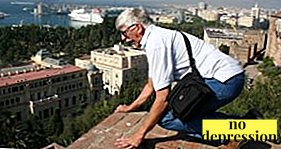 dilated pupils;
dilated pupils;- tremor or numbness of the limbs;
- increased sweating and chills;
- general weakness of the body;
- increased heart rate and pain in the heart;
- an out of control panic;
- the occurrence of shortness of breath and "lump" in the throat;
- increased motor activity and muscle hypertonia.
Features of acrophobia in children
Symptoms of acrophobia in children is slightly different from the signs of a phobic state in adults.
The fundamental difference lies in the risk of complications and the treatment of fear of heights. The child will cope with such a phobia much easierthan an adult person.
The first signals indicating the presence of acrophobia in children are the fear of climbing a roller coaster, riding on a swing, jumping on trampolines.
What to do? Parents in this case need to take several measures. Recommendations to parents:
- the child needs maximum psychological support;
- training can be done gradually (from a small height);
- strengthening the vestibular apparatus plays a special role;
- if the fear of height remains, then it is necessary to seek help from specialists.
Methods to overcome fear

How to overcome the fear of heights? Acrophobia treats well.
With a slight degree of phobic state, correction can be carried out independently.
In severe cases help of specialists (psychologists or psychotherapists) will be inevitable.
In the treatment of a phobic state, various methods are used, including not only psychotherapeutic methods, but also a course of treatment with special medicines that have a beneficial effect on the psyche and emotional state.
Psychotherapeutic effect
The course of psychotherapeutic procedures is selected individually. In drawing up the course of therapy, the doctor takes into account the causes of the phobia, the degree of its manifestation and general state of mind acrophoba.
In some cases, it is possible to get rid of a phobia in several sessions, but if there is a serious damage to the nervous system, an integrated approach is necessary, including the use of several psychotherapeutic tactics.
The following psychotherapeutic procedures are used in the treatment of acrophobia:
- Cognitive-behavioral methods (the doctor’s task is to stop the acrophobe’s fear of heights and develop skills to control his emotional state, this method is one of the most effective methods of dealing with acrophobia).
 Relaxation method (sessions are conducted with the participation of the psychotherapist, the patient is introduced into a trance, sound effects, for example, wind noise) can be used additionally.
Relaxation method (sessions are conducted with the participation of the psychotherapist, the patient is introduced into a trance, sound effects, for example, wind noise) can be used additionally.- Visualization method with the use of hypnosis or without it (a person mentally moves to a height, a specialist helps him cope with his fear, this technique can be carried out independently without the use of hypnosis).
- Individual sessions with a psychologist or psychotherapist, as well as a visit group sessions (during such sessions, the specialist identifies the cause of the fear of heights, corrects the emotional state of the acrophobe and fixes the result with special psychotherapeutic techniques).
Pharmacological therapy
The need for drug therapy for acrophobia occurs in severe cases. The reason for the appointment of drugs is a critical state of mind or lack of results of psychotherapeutic procedures.
The list of medicines is selected individually. On your own, you can only take drugs with a sedative effect (Glycine, motherwort tincture or Valerian).
When treating acrophobia, the following medications can be prescribed:
- drugs with soothing effect (help to eliminate the feeling of anxiety and panic);
 category tools beta inhibitors (the main purpose of using such agents is to block adrenaline);
category tools beta inhibitors (the main purpose of using such agents is to block adrenaline);- antidepressants (drugs normalize the emotional state of the person, the exchange method ensures maximum efficiency).
Recommendations
I'm afraid of heights: how to overcome fear? Acrophobia refers to most common phobias in the practice of psychologists and psychotherapists. Phobic state can occur regardless of age. Experts recommend starting a pathology treatment as early as possible.
The younger the acrophobic, the more chances he has of getting rid of the problem as quickly and efficiently as possible.
Some recommendations must be followed. as prevention and be sure to perform if there are symptoms of abnormal fear of heights.
The main recommendations that will help defeat the phobia:
- If when you are at the height there is a feeling of strong fear, then you must try focus on the object that is next (in no case should you look down or concentrate on objects that are far away).
- The method has good efficiency. replacement visualization (it is necessary to make a selection of images with beautiful landscapes and high-rise objects, every fifth picture should be associated with height, pleasant images should be studied longer, and pictures that cause discomfort should be scrolled faster).
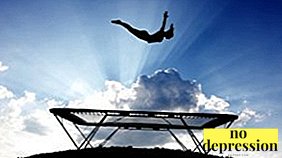 From a very young age recommended train the vestibular apparatus (children need to play outdoor games more often, ride the carousel, jump on trampolines, such games will not only bring joy to the kid, but also eliminate the fear of heights in adulthood).
From a very young age recommended train the vestibular apparatus (children need to play outdoor games more often, ride the carousel, jump on trampolines, such games will not only bring joy to the kid, but also eliminate the fear of heights in adulthood).- Weaning the body to be afraid of heights can be using regular training (gradually it is necessary to rise to a certain height, increasing its level, you can start with a chair, step-ladder, a balcony on the first floor, etc.).
- For trainings it is recommended to choose objects with maximum protection (hedges, railings, glass and other protective fences will help to normalize the emotional state).
Acrophobia can cause extremely negative consequences for humans. This phobia disrupts the nervous system, internal organs and provokes the development of neurotic disorders.
Mental abnormalities in the acute stage can cause suicide with a panic attack. Acrophobia is a must-fight. Otherwise, the negative consequences can not be avoided.
What is useful fear of heights? Find out from the video:

 If a person has suffered an injury as a result of a fall from a height, then for a certain time he will have a fear of high objects (if the state does not normalize within a few months, then specialist help is needed).
If a person has suffered an injury as a result of a fall from a height, then for a certain time he will have a fear of high objects (if the state does not normalize within a few months, then specialist help is needed). dilated pupils;
dilated pupils; Relaxation method (sessions are conducted with the participation of the psychotherapist, the patient is introduced into a trance, sound effects, for example, wind noise) can be used additionally.
Relaxation method (sessions are conducted with the participation of the psychotherapist, the patient is introduced into a trance, sound effects, for example, wind noise) can be used additionally. category tools beta inhibitors (the main purpose of using such agents is to block adrenaline);
category tools beta inhibitors (the main purpose of using such agents is to block adrenaline); From a very young age recommended train the vestibular apparatus (children need to play outdoor games more often, ride the carousel, jump on trampolines, such games will not only bring joy to the kid, but also eliminate the fear of heights in adulthood).
From a very young age recommended train the vestibular apparatus (children need to play outdoor games more often, ride the carousel, jump on trampolines, such games will not only bring joy to the kid, but also eliminate the fear of heights in adulthood).